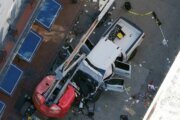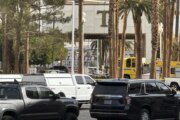DAYTONA BEACH, Fla. (AP) — Chris Buescher caught a glimpse of a mangled car in the infield grass at Daytona International Speedway. He didn’t think much about it at first. Then, as he circled the track under caution, he saw a slow-motion replay of the crash on a giant video board.
It was close friend Ryan Preece’s No. 41 Ford. Buescher refused to watch anymore.
“It’s a dangerous sport. We know that getting in,” Buescher said. “Sometimes you push it a little too far to the back of our minds.”
Preece provided everyone a stark reminder when his car lifted off the ground and flipped uncontrollably in the waning laps of the NASCAR Cup Series regular-season finale at Daytona on Saturday night. Gasps, groans, tears — and eventually sighs of relief and applause — followed.
Preece was able to climb out his window with help before being taken to a hospital for overnight observation. He was released the next morning and cleared to fly home to North Carolina. He will be back behind the wheel soon, another testament to the countless safety improvements that have become mainstays in NASCAR.
Head-and-neck restraints — the HANS device — and SAFER barriers. The two advancements rank as the most significant in NASCAR history.
As part of the celebration of NASCAR’s 75th season, The Associated Press interviewed 12 veteran contributors to the industry on topics ranging from the most memorable race to key challenges ahead. Eight of the 12 contributors said HANS devices were the top safety enhancement.
“The first thing that comes to my mind is the HANS device,” said Edsel Ford II, great-grandson of Henry Ford and a longtime executive of the family’s motor company. “It sparked a revolution in safety and eventually led to NASCAR mandating that all drivers had to wear one. Today, we see it as just another piece of equipment, but quite frankly I believe it’s one of the most important.”
Added Eddie Wood, co-owner and president at Wood Brothers Racing: “There was a time before they became mandatory that Ford would buy any Ford driver a HANS device if you would wear it. That’s how important they knew it was.”
NASCAR’s darkest day came in 2001, when seven-time champion Dale Earnhardt was killed in the final turn of the season-opening Daytona 500. Earnhardt was the fourth national series driver killed in nine months.
NASCAR never stopped after the deaths of Adam Petty, Kenny Irwin Jr. and Tony Roper, but losing Earnhardt forced the racing series to confront safety issues it had been slow to acknowledge.
The dramatic upgrades since have saved multiple lives — NASCAR hasn’t suffered a racing death in its three national series since — and are the hallmark of Earnhardt’s legacy.
NASCAR mandated the use of head-and-neck restraints in late 2001. Drivers had resisted using the U-shaped device made of carbon fiber because they found it cumbersome and restrictive.
“Unfortunately, it takes a death for new safety equipment/measures to be implemented,” said longtime motorsports writer Deb Williams.
Williams pointed to the deaths of Joe Weatherly, Glenn Roberts Jr., Jimmy Pardue and Billy Wade between 1964 and ’65, saying they led to six-point harnesses, tire inner liners and fire-retardant uniforms.
The next wave of progress followed the deaths of Petty, Irwin, Roper and Earnhardt.
“The most important one was the HANS device,” Williams said. “Drivers have suffered concussions, but since the HANS device was required, there hasn’t been a fatality in NASCAR’s top three series from a basal skull fracture.”
Voting for the HANS device was far from unanimous. Three of the 12 contributors, including three-time Daytona 500 winner Denny Hamlin and NASCAR executive Steve O’Donnell, called SAFER barriers the No. 1 advancement.
“Without them, we would have far more concussions, far more broken bones,” Hamlin said.
The Steel And Foam Energy Reduction Barrier was designed to absorb and reduce kinetic energy during high-speed crashes. Also dubbed “soft walls,” they have been gradually added to nearly every NASCAR track.
“If you look at the industry coming together, it was a unified effort in the name of safety,” O’Donnell said. “Without question, this enhancement has saved countless lives. There was full collaboration from key stakeholders not only within NASCAR, but the entire motorsports community as a whole.”
Winston Kelly, executive director at the NASCAR Hall of Fame, said SAFER barriers “transcend all forms of motorsports.”
Several contributors considered HANS devices and SAFER barriers equally critical to NASCAR’s technology breakthroughs. Other safety innovations that received votes: fuel cells, carbon-fiber seats, padding around drivers’ helmets, insulation inside the cockpit and window nets.
All of them came into play during Preece’s crash. They helped make his car undoubtably the safest in NASCAR history.
“Certainly looked very violent and very airborne,” said Buescher, who compared it to his ferocious rollover at Charlotte Motor Speedway in May 2022. “It beats you up. I haven’t seen it, so I don’t know how big of a sudden stop or one major impact along the way. I just know that it was painful in the fact that it’s knocking you around so many different directions so quickly. It just doesn’t feel good. There’s no way to go about it.
“Appreciative of how safe our race cars are. I think as an industry sometimes we forget that it is dangerous still, and that can certainly lead to some of our wilder moments.”
___
AP auto racing: https://apnews.com/hub/auto-racing
Copyright © 2025 The Associated Press. All rights reserved. This material may not be published, broadcast, written or redistributed.






